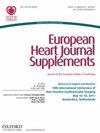Assessment of cardiac functions using two-dimensional transthoracic and speckle tracking echocardiography after treatment with SGLT2 inhibitors in Patients with HFrEF
IF 1.7
4区 医学
Q3 CARDIAC & CARDIOVASCULAR SYSTEMS
引用次数: 0
Abstract
Abstract Background & objective Recently, the antidiabetic drug sodium-glucose cotransporter type 2 inhibitor (SGLT2i) has been approved among the drugs that reduce mortality in patients with HFrEF. The impact of SGLT2i inhibitors on the left ventricle longitudinal myocardial function in heart failure (HF) patients remained vague. The effect of SGLT2i on left ventricular remodeling and function in patients with HFrEF was studied using STE and traditional echocardiography. Objectives Studying the effects of SGLT2i on left ventricular remodeling and function in HFrEF patients using STE and traditional echocardiography. Methods 300 patients with HFrEF were included.Study design: This prospective observational study involves 300 patients with HFrEF-administered SGLT2i (Empagliflozin & Dapagliflozin) in addition to the classical treatment of heart failure. Then the patients were followed up 2, 4 & 6 months after treatment with laboratory investigations of HbA1C and eGFR, in addition to 2D echo & STE studies. Results Regarding Demographic data, the mean age was 50 ± 9.2 for males and females. The mean weight, height, and body mass index (BMI) were 85.6 ± 8.8 kg, 178.6 ± 7.2 cm, and 26.6 ± 2.9, respectively. The systolic blood pressure (SBP) and diastolic blood pressure (DBP) were 115.3 ± 5.1 and 75.4 ± 4.5, respectively. The mean heart rate was 79.9 ± 10.2. The mean respiratory rate was15 ± 2.2. Regarding functional NYHA class, 1 (0.2%), 54(12%), 392 (87.1%), and 3 (0.7%) patients were class I, II, III, and IV, respectively. The lab investigations at first presentation were: mean HbA1C was 4.2 ± 0.6, and the mean of eGFR was 66.4 ± 9.3. Concerning Echocardiography data of patients LVEF by 2D echo show significant improvement from 34.73 ± 2.9 at baseline to 34.91 ± 1.2, 35.42 ± 3.5 & 36.54 ± 3.6 at 2, 4 & 6 months (P = 0.001) also GLS A4 showed significant improvement from −15.67 ± 2.74 to −16.5 ± 3.19, −17.32 ± 3.21, −18.03 ± 3.05at 2, 4 & 6 months (P = 0.001), and from −15.66 ± 2.65 to −16.50 ± 3.31, −17.41 ± 3.23 & −17.93 ± 3.32 (P = 0.001) by GLS A2 Regarding dapagliflozin LVEF by 2D echo show significant improvement from 34.87 ± 2.86 at baseline to 34.87 ± 2.86, 35.05 ± 3.01& 37.53 ± 4.1 at 2, 4 & 6 months (P = 0.001) also GLS A2 showed significant improvement from −15.67 ± 2.74 to −16.50 ± 3.31 −17.41 ± 3.23 −17.93 ± 3.32 at 2, 4 & 6 months (P = 0.001), and from −15.54 ± 2.77 to −16.84 ± 3.49, −18.48 ± 2.23 & −19.61 ± 2.98 (P = 0.001) by GLS A4, also E/e′ significantly reduced from 11.2 ± 2.7 to 9.1 ± 2.3 cm/s after administration of empagliflozin and dapagliflozin within 6 months (P = 0.01) also LAVI (ml/m2) improved from 45.6 ± 15.3 to 37.5 ± 6.5 (P = 0.001) after 6 month The results revealed a significant increase of ejection fraction at 4 and 6 months follow-up and a significant improvement of global longitudinal strain at 2, 4 & 6 months follow-up in patients given SGLT2i. Conclusion SGLT2i was associated with improving LV longitudinal myocardial function, further improving LV diastolic function. SGLT2i is associated with increased EF and LV longitudinal myocardial function. Additional Content An author video to accompany this abstract is available on https://academic.oup.com/eurheartjsupp. Please click on the arrow next to ‘More Content’ and then click on ‘Author videos’.在HFrEF患者接受SGLT2抑制剂治疗后,使用二维经胸和斑点跟踪超声心动图评估心功能
背景&最近,降糖药钠-葡萄糖共转运蛋白2型抑制剂(SGLT2i)被批准为降低HFrEF患者死亡率的药物之一。SGLT2i抑制剂对心力衰竭(HF)患者左心室纵向心肌功能的影响尚不清楚。应用STE和传统超声心动图研究SGLT2i对HFrEF患者左室重构和功能的影响。目的应用超声心动图和超声心动图研究SGLT2i对HFrEF患者左室重构和功能的影响。方法对300例HFrEF患者进行分析。研究设计:这项前瞻性观察性研究纳入了300例hfref给药的SGLT2i(恩格列净;达格列净(Dapagliflozin))是治疗心衰的经典方法之一。然后对患者进行随访2,4 &治疗后6个月,实验室检查HbA1C和eGFR,并进行二维超声检查;STE的研究。结果人口统计学方面,男女平均年龄为50±9.2岁。平均体重(85.6±8.8 kg)、平均身高(178.6±7.2 cm)、平均体重指数(BMI)(26.6±2.9)。收缩压(SBP)为115.3±5.1,舒张压(DBP)为75.4±4.5。平均心率为79.9±10.2。平均呼吸频率为15±2.2。在功能性NYHA分类中,I、II、III、IV类患者分别为1例(0.2%)、54例(12%)、392例(87.1%)和3例(0.7%)。首次就诊时的实验室检查结果为:平均HbA1C为4.2±0.6,平均eGFR为66.4±9.3。患者LVEF二维超声心动图数据由基线时的34.73±2.9改善为34.91±1.2,35.42±3.5;36.54±3.6 at 2,4 &6个月(P = 0.001) GLS A4也有显著改善,从- 15.67±2.74到- 16.5±3.19,- 17.32±3.21,- 18.03±3.05at 2,4 &;6个月(P = 0.001),从−15.66±2.65到−16.50±3.31,−17.41±3.23;2D回声显示,达格列净LVEF由基线时的34.87±2.86显著改善至34.87±2.86,35.05±3.01;37.53±4.1 at 2,4 &6个月(P = 0.001), GLS A2在2,4 &时也从- 15.67±2.74显著改善到- 16.50±3.31 - 17.41±3.23 - 17.93±3.32;6个月(P = 0.001),从−15.54±2.77到−16.84±3.49,−18.48±2.23;在给药后6个月内,E/ E′从11.2±2.7降低到9.1±2.3 cm/s (P = 0.01), LAVI (ml/m2)从45.6±15.3提高到37.5±6.5 (P = 0.001)。结果显示,在随访4和6个月时,射血分数显著增加,在2、4和amp时,全球纵向应变显著改善;SGLT2i患者随访6个月。结论SGLT2i可改善左室纵向心肌功能,进一步改善左室舒张功能。SGLT2i与EF和LV纵向心肌功能增加有关。一个作者的视频,伴随着这个摘要可在https://academic.oup.com/eurheartjsupp。请点击“更多内容”旁边的箭头,然后点击“作者视频”。
本文章由计算机程序翻译,如有差异,请以英文原文为准。
求助全文
约1分钟内获得全文
求助全文
来源期刊

European Heart Journal Supplements
医学-心血管系统
CiteScore
3.00
自引率
0.00%
发文量
575
审稿时长
12 months
期刊介绍:
The European Heart Journal Supplements (EHJs) is a long standing member of the ESC Journal Family that serves as a publication medium for supplemental issues of the flagship European Heart Journal. Traditionally EHJs published a broad range of articles from symposia to special issues on specific topics of interest.
The Editor-in-Chief, Professor Roberto Ferrari, together with his team of eminent Associate Editors: Professor Francisco Fernández-Avilés, Professors Jeroen Bax, Michael Böhm, Frank Ruschitzka, and Thomas Lüscher from the European Heart Journal, has implemented a change of focus for the journal. This entirely refreshed version of the European Heart Journal Supplements now bears the subtitle the Heart of the Matter to give recognition to the focus the journal now has.
The EHJs – the Heart of the Matter intends to offer a dedicated, scientific space for the ESC, Institutions, National and Affiliate Societies, Associations, Working Groups and Councils to disseminate their important successes globally.
 求助内容:
求助内容: 应助结果提醒方式:
应助结果提醒方式:


